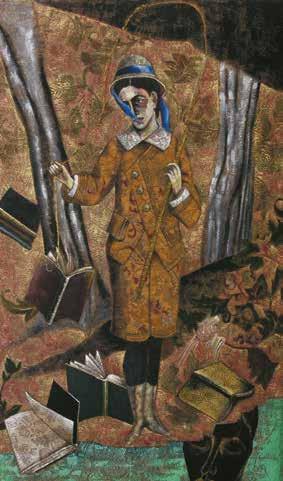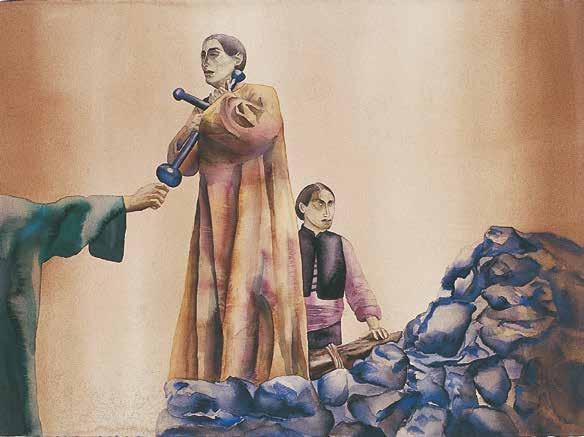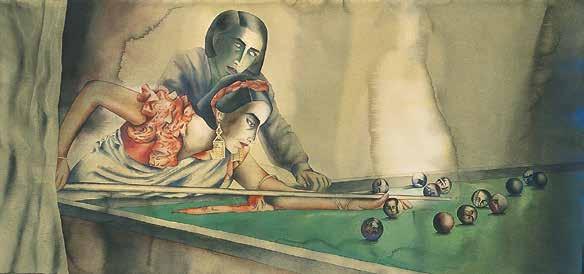
14 minute read
PRIVATE SELF: ANJU DODIYA
from India 20
Private Self
ANJU DODIYA
Advertisement
Although the central protagonist of Anju Dodiya’s oeuvre is a FECUND, CREATIVE SELF-IMAGE, her work is devoid of
overt feminist concern: her preoccupation and delight lie with the private self.
Primarily a watercolourist, Dodiya has also created a fascinating body of work on tapestries, mattresses and fabric.
The source material for her ‘daily dramas’ and terrifying tableaux is eclectic: she draws from diverse disciplines;
specifi c areas of inquiry include 19th-century Japanese Ukiyo-e prints, world cinema, print-media photographs,
fashion catalogues and images and text gleaned from the Internet.
Highly complex, her imagery has its genesis (through association) in personal objects/images that hark to
wellsprings of memory. A highly informed painter, her work is like a well-orchestrated suite that combines formal
sophistication with vigorous intellectual inquiry.
Entering it calls for an awareness of private codes of meaning that lace her pictorial image. An informed
sensibility is a prerequisite in this activity, as the artist does not believe in straightforward explanations.
AM: Watercolour remains your mainstay… AD: Yes, I enjoy watercolour…maybe because of the discipline it demands. There is tension – every mark you make, stays. In spite of the spontaneity and quickness of application, there’s a strong sense of unpredictability. So it suits my temperament, this edginess. The control of the medium and the formal play continue to remain important. Strangely, though, I feel quite vulnerable despite years of practice…
AM: But you are exceedingly profi cient with the medium… AD: Yes, it’s a profi ciency that I am aware of. But at the same time, the medium has its own nature and water will behave like water! Even the seasons affect it! In recent years, I’ve moved towards other mediums – charcoal, for instance. I chose charcoal because of the darkness it yields and the feeling of working as though with dust. It gives me a sense of aggressive power. But when I use it with watercolour, the dust fl oats, and again, it’s unpredictable. So there is a constant play between control and abandon. AM: What defi nes these choices? AD: Many things…. In the past few years I have enjoyed working with fabric because of the texture that it provides to the heads that I paint, a different skin, so to speak. I also enjoy the sensation of rubbing paint on the tactile textile surface. It’s very sensual. I fi nd that I’m most playful with fabric. It also has to do with the fact that there is no white – you remember that fear of white that I have often spoken about. With fabric, there’s already a ground that is laid out. The readymade pattern provides safety and continuity, a ready backdrop against which to develop the imagery. It sets up a relationship of interaction with the surface, against that of imposing images on it. Gravitating towards fabric also stems from my interest in medieval tapestries. When I started out with watercolour, it was a total accident. My father had got me a box of Winsor and Newton watercolours. I started because I didn’t want to waste it! But, surprisingly, I discovered an ease with the medium. Because I’d worked with collages – layering, in terms of washes, came naturally, and I just fell for it. Fabric, on the other hand, provides a softer approach – it’s more lyrical. The mattress works took off from the Grand Hyatt Commission. I was supposed to do the Shiva-Parvati marriage. It was 14 by 12 feet and I thought of breaking up the space into fragmented drawings on cloth. And then, since the subject was a marriage, I said to myself, ‘Why not a mattress?’ I enjoyed working on that surface, the thick paint… slapping it on. I enjoyed that physical presence – I call it a pregnant painting. Then Gayatri Sinha was curating a show at Sakshi called After Dark for which I continued doing those works. It wasn’t just about innovation or experimenting on a new surface. Content determined these choices…the
obvious sleep/dream/desire connotations. The

Cloud Hunter, acrylic on mattress, 46 x 7 x 78”, 2005
artist’s insomnia, anxiety and creative dilemmas were re-lived on the bed. There are a lot of subconscious associations with surfaces. The fl oral patterns point to the fertility metaphor. The choice of kitschy upholstery fabric generally used for middle-class sofas and curtains getting thrown in with high-art images like those of Dürer and Utamaro, delighted me.
AM: The scale of your paper works has opened up… AD: I have been working on large-scale works on paper since 2000. Though, in these new works that I am doing, it is more full-fl edged simply because of the overwhelming space where the work will be shown. This will be in Vadodara at the Laxmi Vilas Palace. I’m looking at it as an installation of drawings in the Durbar Hall. I’m planning a huge carpet of mirrors and the drawings will surround it. The backs of the works will be in fabric, so when you enter you’ll see colourful backs, almost like courtiers, and the mirrors will refl ect the whole grandeur of the space, the past glory as well as the decay. So the work is about all that, plus it is a kind of inward refl ection, a meditation on loss, on wealth and on the passing of time. I hope it is grandiose with an element of danger!
AM: Is the self-image a narcissistic concept in any way in your work? AD: Not at all! Initially, the self-image used to be very frontal, almost a study. I used to sketch myself…as a nocturnal diary. Later it built into a visual allegory or play. And now I fi nd it very funny and idiotic when people use the word ‘self-image’. It is just a take-off point, sometimes…
AM: So how did it come up? AD: It drew from the myth, and the idea of ‘looking into’ yourself through your refl ection. Self-examination is considered being narcissist in certain cultures.
AM: Parody remains an important element of your vocabulary. Do you use it consciously to make a larger social comment? AD: It’s almost self-mocking. When I say ‘self’, I include the artist self and that becomes the artist as the performer, the artist as part of the market, the artist as the critic’s victim – all that is also part of the parody. I don’t mean just the lonely artist brooding over his or her images.

Pale Mourner, watercolour on paper, 22 x 30”, 2004 AM: Does irony not become a double-edged sword, given that you indulge in a sort of dual play? AD: There is a work of 1998, Studio Guests – there are these European visitors watching sword swallowers – in which the reference is to artists who have to perform for international curators. There’s always an international menu. I have also made paintings where I make fun of the aspect of needing to paint, in spite of having nothing signifi cant to say.
AM: But does that hold true even today? AD: I’ve done two or three images like that. In one
there’s this huge crown, in a work titled Coronation and there’s a pencil dangling from it. The pencil in front of the artist’s eyes…it’s mocking. You want to create and go with the territory. Yet it all sounds vain and banal. I think there is a sense of humour and serious self-mockery that’s going on. That’s what saves me…otherwise, I’m quite neurotic and obsessive in my hunt for the image.
AM: How do you deal with the pressure from galleries when, like you said, you don’t have anything to say and yet have to produce… AD: I have been very consistently controlled about this. I’ve always said ‘no’. I have my own rhythm with work and I can’t make art because I’m asked to. I paint for myself. When you are alone in the studio, a private anxiety takes over. I would feel physically unwell if I didn’t paint. In spite of all the control, experience, I think on some level I am an expressionist painter. Certain images arrive and I need to paint them. There is some kind of secret order or code which I unravel while working. The viewer unravels it in his or her own way…

Studio Guests, watercolour on paper, 42 x 28”, 1998
AM: Do you lead the viewer on? AD: I create an emotional climate in the work. Give the viewer clues. But fi nally, the viewer is free to interpret the narrative. Perhaps…for example, a personal stress of a very different kind may have prompted a work, but sitting here in front of you, I might allow you to think in a certain direction, because it suits me to…it’s perverse, I know.
AM: How important are the formal devices in the process of resolving a work? AD: The resolution of the image…well, I think, formally one tries. Sometimes, the content remains in a kind of fl oating zone. I’m interested in a certain range of images and it’s not as if I always know what I’m doing or creating, but at the end of a body of work, it makes a certain kind of sense. The structure and order are articulated only after the work is made. It is driven mainly by the emotional nuances attached to the image.
AM: The repertoire of imagery from which you draw gets richer…do you consciously search these out on a daily basis? AD: Basically, I’m a voracious eater where visual images are concerned. I just want to see everything, especially while travelling. The morning starts with looking at four, fi ve newspapers – I have to, it’s almost compulsive. I have to look at everything: ads, movie ads and sports images. I collect sports images as a bank of facial expressions; over the years, I’ve put together a very strong archive. I fi nd that the emotions that we control in regular day-to-day life come to the fore during active sports and you see a fi erce psychological drama happening…say, during tennis matches or in the violence of football. Faces interest me very much. Over the years, cinema has been my most important visual bank. Looking at Bergman, Ray, Godard, I have learnt so much about the psychological repercussions of a visual frame. How colour, light and tonality can generate expression!
I also look at contemporary fashion a lot. It’s been a very important source, actually. Not just formally, but in terms of details, of the costume and the underlying philosophy of fashion, as in the case of Japanese designers – I think it’s fantastic the way they break the form while cloaking the body. The body is almost denied. There is a Japanese designer, Rei Kawakubo, 40s-born; in one of her famous designs she creates padding on the back such that the wearer appears hunchbacked…she distorts the body to make the ‘beautiful’ look ‘ugly’, almost unreal. It really sets up a disturbance. It sets you thinking about natural form and the desired form. Dress can be a profound metaphor for the human condition! I fi nd this quite exciting.
AM: Beauty and disturbance coexist in the work… AD: Yes, that is a very important concern. I do imbue a work with systematic rupture. Beauty is a major concern, yet I have a need to disrupt it. For example, after making a rugged drawing, if I use water on it, the water takes its own path and gives me these unpredictable carpets all over the image – so there’s the need to unsettle the image. Formal unsettling is one aspect of this. I often play on the edge of the sentimental and the disturbing. It’s about going backwards and forwards with image and time. It’s as if I am making something and rejecting it. The work, then, remains in a state of constant tension, which is exciting for me. It’s also about defl ating the creative ego…I’m laughing, but I really feel that art is a spiritual quest – I feel like a blessed being, really, knowing that I am able to paint.
AM: Would you care to dwell on abiding infl uences that remain amid the increasing range of references and source material? AD: I started out with the very strong infl uence of the Japanese Ukiyo-e prints. Even today, I often refer to that vocabulary, the quality of lines and the overall elegance. Their depiction of sex and violence is visually stunning and theatrical. Music is something that I enjoy – 50s fi lm music: Talat Mehmood, Geeta Dutt…the sticky, lyrical quality entered the suite of paintings that I exhibited at Bose Pacia. Since I started the palace works, I have been listening to Kishori Amonkar…there is the element of the female heroic in her work. All these things enter the work in a roundabout manner and enrich its emotional quotient.
AM: …specifi c writers, thinkers, artists…? AD: Reading has provided a private fantasy world and in fact brought dangerously ‘literal’ qualities to my image-making. Setting up stories, characters and costume-dramas…maybe I overdo it sometimes. While painting, I often think of Bhupen Khakhar – that he made a virtue of his limitations, as in his approach to drawing. There’s always this kind of tentativeness or nervousness that I experience when I approach my own work. So I fi nd his attitude inspiring. Through college, and even today, I fi nd Rauschenberg‘s sense of colour and his joyous approach to material delightful. His textile works were at the back of my head when I began

Island of Greed, acrylic on mattress, 46 x 7 x 78”, 2004
on the mattress idea. In the past few years I’ve also been inspired by Marina Abramovich’s monk-like approach and the spiritual inclination in her work.
Let me say it’s been a great delight looking at all these Souza works which we had never seen before, which are resurfacing in all these auction catalogues. There is a powerful, direct energy there, which I aspire to.
AM: Your own approach is a bit like gearing up for war… AD: Yes, that’s very much part of my approach. I am like a martial artist in some ways. There is tension, a sense of ritual, rigour, and tight intention. All this when I start! Then slowly, I get into desperado mode!

The Path of Berries, acrylic on mattress, 46 x 7 x 78”, 2006
ANJU DODIYA was born in 1964 in Mumbai. She completed her Bachelor’s degree in Fine Arts from Sir JJ School of Art, Mumbai. She has held seven solo exhibitions and participated in several national and international group exhibitions. She was twice nominated for the Sotheby’s Award for contemporary art.
She lives and works in Mumbai.

Joan – I(After Carl Dreyer), watercolour on paper, 30 x 22”, 1997
Lovers, watercolour on paper, 70 x 22”, 1998

Cucoon, watercolour on paper, 45 x 70”, 2000

The Game, watercolour on paper, 70 x 33”, 2000


Spaghetti Shiva, watercolour and charcoal on paper, 45 x 70”, 2002

Forked, acrylic on fabric, 42 x 72”, 2005
unravel while working.
ANJU DODIYA

ARTIST’S PORTRAIT: NRUPEN MADHVANI SELECT SOLO EXHIBITIONS
2007: Vadehra Art Gallery, New Delhi 2007: Chemould Prescott Road, Mumbai 2007: Museum Gallery, Mumbai 2006: Sumukha Gallery, Bengaluru 2006: Bodhi Art, New Delhi, Mumbai, New York 2006: Singapore Tyler Print Institute, Singapore 2005: Faculty of Fine Arts, Vadodara 2005: Bose Pacia, New York 2004: Faculty of Fine Arts, MS University, Vadodara 2003: Bose Pacia, New York 2002: Walsh Gallery, Chicago 2002: Reina Sofi a Museum, Madrid 2002: Sakshi Gallery, Mumbai 2001: The Japan Foundation Asia Centre, Tokyo 2001: The Fine Art Resource, Berlin





